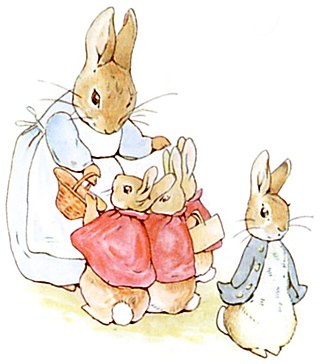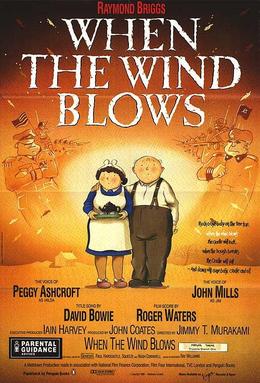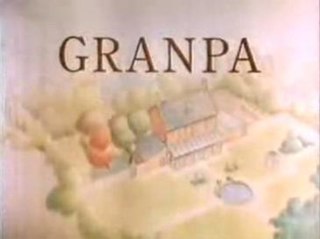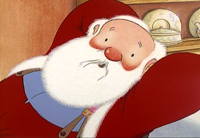
A picture book combines visual and verbal narratives in a book format, most often aimed at young children. With the narrative told primarily through text, they are distinct from comics, which do so primarily through sequential images. The images in picture books can be produced in a range of media, such as oil paints, acrylics, watercolor, and pencil. Picture books often serve as pedagogical resources, aiding with children's language development or understanding of the world.

The Snowman is a 1982 British animated television film and symphonic poem based on Raymond Briggs's 1978 picture book The Snowman. It was directed by Dianne Jackson for Channel 4. It was first shown on 26 December 1982, and was an immediate success. It was nominated for Best Animated Short Film at the 55th Academy Awards and won a BAFTA TV Award.
Sir Quentin Saxby Blake, is an English cartoonist, caricaturist, illustrator and children's writer. He has illustrated over 300 books, including 18 written by Roald Dahl, which are among his most popular works. For his lasting contribution as a children's illustrator he won the biennial international Hans Christian Andersen Award in 2002, the highest recognition available to creators of children's books. From 1999 to 2001, he was the inaugural British Children's Laureate. He is a patron of the Association of Illustrators.

Raymond Redvers Briggs was an English illustrator, cartoonist, graphic novelist and author. Achieving critical and popular success among adults and children, he is best known in Britain for his 1978 story The Snowman, a book without words whose cartoon adaptation is televised and whose musical adaptation is staged every Christmas.
The Carnegie Medal for Illustration is a British award that annually recognises "distinguished illustration in a book for children". It is conferred upon the illustrator by the Chartered Institute of Library and Information Professionals (CILIP) which inherited it from the Library Association. CILIP is currently partnered with the audio technology company Yoto in connection with the award, though their sponsorship and the removal of Greenaway’s name from the medal proved controversial.

Charles William James Keeping was an English illustrator, children's book author and lithographer. He made the illustrations for Rosemary Sutcliff's historical novels for children, and he created more than twenty picture books. He also illustrated the complete works of Charles Dickens for the Folio Society.

The Iron Man: A Children's Story in Five Nights is a 1968 science fiction novel by British Poet Laureate Ted Hughes, first published by Faber and Faber in the UK with illustrations by George Adamson. Described by some as a modern fairy tale, it narrates the unexpected arrival in England of a giant "metal man" of unknown origin who rains destruction on the countryside by eating industrial farm equipment, before befriending a small boy and defending the world from a dragon from outer space. Expanding the narrative beyond a criticism of warfare and inter-human conflict, Hughes later wrote a sequel, The Iron Woman (1993), describing retribution based on environmental themes related to pollution.
The Lewis Carroll Shelf Award was an American literary award conferred on several books annually by the University of Wisconsin–Madison School of Education annually from 1958 to 1979. Award-winning books were deemed to "belong on the same shelf" as Alice's Adventures in Wonderland and Through the Looking-Glass by Lewis Carroll, having enough of the qualities of his work.

Santa Claus Is Comin' to Town is a 1970 stop motion Christmas television special produced by Rankin/Bass Productions in New York, New York. The film is narrated by Fred Astaire and stars the voices of Mickey Rooney, Keenan Wynn, Robie Lester, Joan Gardner and Paul Frees, as well as an assistant song performance by the Westminster Children's Choir. The film tells the story of how Santa Claus and several Claus-related Christmas traditions came to be. It is based on the hit Christmas song, "Santa Claus Is Comin' to Town", which was written by J. Fred Coots and Haven Gillespie for Leo Feist, Inc. and introduced on radio by Eddie Cantor in 1934; and the story of Saint Nicholas.

When the Wind Blows is a 1986 British adult animated disaster film directed by Jimmy Murakami based on Raymond Briggs' graphic novel of the same name. The film stars the voices of John Mills and Peggy Ashcroft as the two main characters and was scored by Roger Waters. The film recounts a rural English couple's attempt to survive a nearby nuclear attack and maintain a sense of normality in the subsequent fallout and nuclear winter.
Martin Waddell is a writer of children's books from Belfast, Northern Ireland. He may be known best for his picture book texts featuring anthropomorphic animals, especially the Little Bear series illustrated by Barbara Firth.

Granpa is a British family-oriented animated film that adapts a picture book by John Burningham. Produced by TVS for Channel 4 Television in 1989, it was released on VHS by PolyGram Video in 1994.

Father Christmas is a 1991 British animated short film starring Mel Smith as Father Christmas. Created for Channel 4 and first broadcast on Christmas Eve 1991 in Britain, the story is an adaption of two books written by Raymond Briggs - Father Christmas and Father Christmas Goes on Holiday - and is the second animated adaptation of Briggs' work made for the channel, following the 1982 animated short The Snowman.
The Kurt Maschler Award was a British literary award that annually recognised one "work of imagination for children, in which text and illustration are integrated so that each enhances and balances the other." Winning authors and illustrators received £1000 and a bronze figurine called the "Emil".
Andrew Timothy Davidson is a British artist. His book illustrations include two novels by Ted Hughes: The Iron Man and its sequel The Iron Woman (1993). Another is a 2002 edition of Jack London's The Call of the Wild. Some time after that, Andrew illustrated for the book Tales of the Peculiar by Ransom Riggs.
Helen Gillian Oxenbury is an English illustrator and writer of children's picture books. She lives in North London. She has twice won the annual Kate Greenaway Medal, the British librarians' award for illustration and been runner-up four times. For the 50th anniversary of that Medal (1955–2005) her 1999 illustrated edition of Alice's Adventures in Wonderland was named one of the top ten winning works.

The Jolly Postman or Other People's Letters is an interactive children's picture book by Janet and Allan Ahlberg. The innovative project required five years to complete, and much discussion with both the publisher Heinemann and the printer before it was issued in 1986. The first subject heading assigned by WorldCat is "Toy and movable books". Little, Brown published a U.S. edition in the same year.

The Arrival is a wordless graphic novel written by Shaun Tan and published by Hodder Children's Books in 2006. The book is 128 pages long and divided into six chapters; it is composed of small, medium, and large panels, and often features pages of full artwork. It features an immigrant's life in an imaginary world that sometimes vaguely resembles our own. Without the use of dialogue or text, Shaun Tan portrays the experience of a father emigrating to a new land. Tan differentiates The Arrival from children's picture books, explaining that there's more emphasis on continuity in texts with multiple frames and panels, and that a graphic novel text like his more closely resembles a film making process. Shaun Tan has said he wanted his book to build a kind of empathy in readers: "In Australia, people don't stop to imagine what it's like for some of these refugees. They just see them as a problem once they're here, without thinking about the bigger picture. I don't expect the book to change anybody's opinion about things, but if it at least makes them pause to think, I'll feel as if I've succeeded in something."
Fritz Wegner was an Austrian-born illustrator, resident in the United Kingdom from 1938.

The Snowman is a wordless children's picture book by British author Raymond Briggs, first published in 1978 by Hamish Hamilton in the United Kingdom, and published by Random House in the United States in November of the same year. The book won a number of awards and was adapted into an animated television film in 1982 which is an annual fixture at Christmas.












